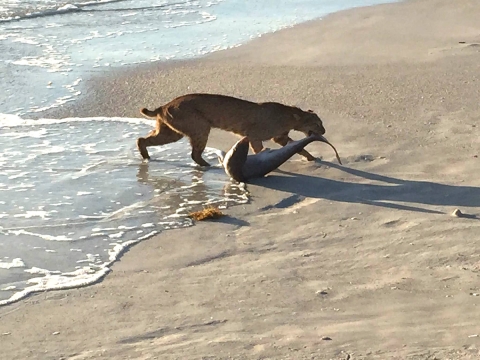The Backstory: On a stroll while at Sebastian Inlet State Park, John Bailey noticed what he thought was a dog staring into the water. Upon closer inspection he realized it was a bobcat, transfixed on a shark feeding on some smaller fish. All of a sudden, the bobcat leapt into the water atop the shark and dragged it ashore! After Bailey took the photo the cat dropped its catch and ran into the woods. So what can we learn about this bobcat fishing for one of the ocean’s top predators?
As blogs and news stations pick up the story and it’s deemed “viral” online, we wanted to take a closer look at the situation.
Bobcat vs. Shark: Meet the Animals
Yes, this is a photo of a bobcat. We received a number of questions online as to whether this was “really was a bobcat” and if the photo was real. There are several things that make biologists confident that it is in fact a bobcat. The size of the animal, the spot on the back of the ears and hind legs, and the characteristic bobtail all point to a bobcat.
Identifying the Shark
Because of the angle of the animal, identifying the shark proved a bit trickier. Our best guess is Atlantic sharpnose shark, Rhizoprionodon terraenovae.
While it's a tough picture from which to identify the shark, one key feature seems evident, the placement of second dorsal relative to the anal fin. The origin of second dorsal appears about the mid-point of the anal fin. This is what leads people The adults are usually a little under three feet.
This shark and an array of other shark species are typically within the surf zone and adjacent nearshore waters in this area of Florida during this time of year.
Bobcats fishing for sharks?
Studies have shown that bobcats mostly eat rabbits and rodents (rodents such as cotton rats, mice and squirrels), but will also eat birds, deer and occasionally reptiles and amphibians. It’s somewhat unusual for bobcats to eat fish and fish typically would make up only a very small percentage of the diet. Bobcats are opportunistic hunters but it’s unlikely bobcats often actively search for fish to catch. However, it is probably something they will do if the chance presents itself.
The bobcat is found widely distributed throughout most of North America, and has adapted well to neighborhoods throughout Florida. It's equally at home in deep forest, swamps, and hammock land. Thick patches of saw palmetto and dense shrub thickets are important as den and resting sites in Florida.
Where Was the Photo Taken?
The direction of the shadows in the photo were confusing some people as well, so we wanted to clarify that there are coastal areas on the west and east sides of this park.
This story is part of our Open Spaces blog.




